Bibliothèque Nationale, Ms. fr. 17001
Miélot left a number of minutes for other translated texts, trial pages of his large illuminated initials, and verses and texts of his own composition which are bound together in Ms. fr. 17001. It is a folio volume of 116 pages on paper, 41 × 28.5 cm., a section of which has the same watermark as the minute of the Speculum .[19] Entirely in Miélot's hand, the drafts are from various dates up to 1470. Three major translations are included: L'Epistre de Cicéron à son frère Quintus; Briève compilation des histoires de toute la Bible ; and Histoire du mors de la pomme .[20]
The manuscript opens with a table of contents added by a later owner which omits many of the texts included in the volume. Folio 2 recto relates the legend, widely accepted in the Middle Ages, concerning the naming of Adam, which had an oriental origin as indicated by the Greek names of the four stars involved. Miélot relates that God sent the four archangels to the four corners of the earth, and they returned in succession with the initial letters of the stars they found there: Anatole, Disis, Arthos, Messembrios. Folio 2 verso is devoted to a large labyrinth or maze in which the letters M I E L O T may be found. A labyrinth of this sort appears in the pavement of the cathedral of Amiens, in which bishopric Miélot was born, and evidently provided inspiration for him. These elaborate paving mazes exist in the floors of many medieval churches and sometimes contain the name of the master designer.
Folio 3 recto carries a large illuminated C (fig. III-13) enclosing a drawing of a lavishly robed king and a lady, in a vaulted room. Below are the letters O P Y E composed of strapwork bands, to spell "COPYE." On the verso (fig. III-14) is an equally elaborate large D framing a portrait of a bishop, inscribed at the base "Saint Foursy Confes." Below the illuminated D are the strapwork bands of the letters U N E, to spell "D'UNE" beside a plain moon face in the position of a following letter, the significance of which is mysterious.
There is a large illuminated M on 4 verso (fig. III-15) like that in the minute for the Miroir , decorated with spiral acanthus leaves. "Saint Foillain m(ar)tir, Frère a St. Foursy" appears in the left arch of the letter and "Saint Ultain, Confes., Frère a St. Foursy," in the right. Below are the illuminated letters I N U T E. The three pages together, with their fantastic graphic elaboration, simply spell "Copye d'une Minute." The last word ends with another illuminated E and a P, separated with fish motifs, which may have been done only to fill out the line.
[19] Briquet, op.cit. , watermark 3544; also found in B.N. Ms. fr. 17001 are watermarks 1739 and 1740.
[20] Robert Bossuat, "Jean Miélot, traducteur de Cicéron," in Bibliothèque de l'Ecole des Chartes, XCIX (1938).
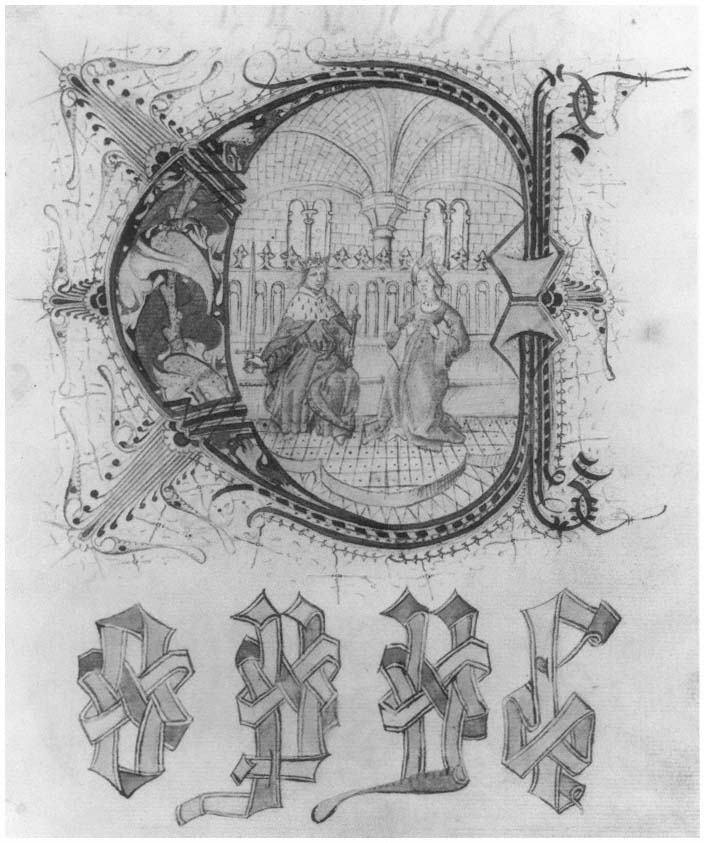
III-13.
Historiated initial and strapwork letters for "COPYE."
Jean Miélot workbook.
Bibliothèque Nationale, Paris, Ms. fr. 17001, fol. 3 recto.
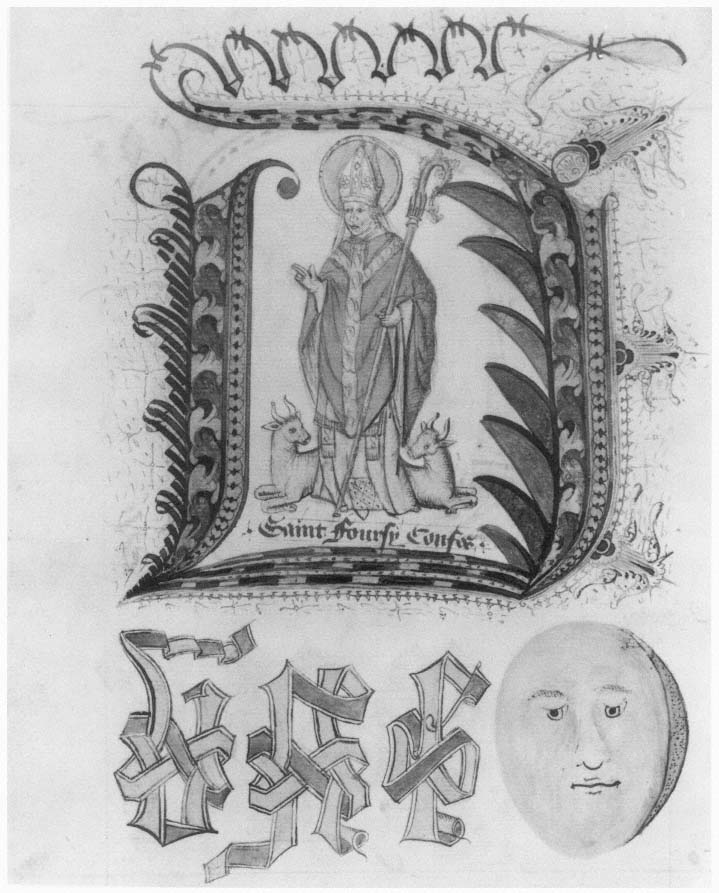
III-14.
Historiated initial for "D'UNE."
Jean Miélot workbook.
Bibliothèque Nationale, Paris, Ms. fr. 17001, fol. 3 verso.
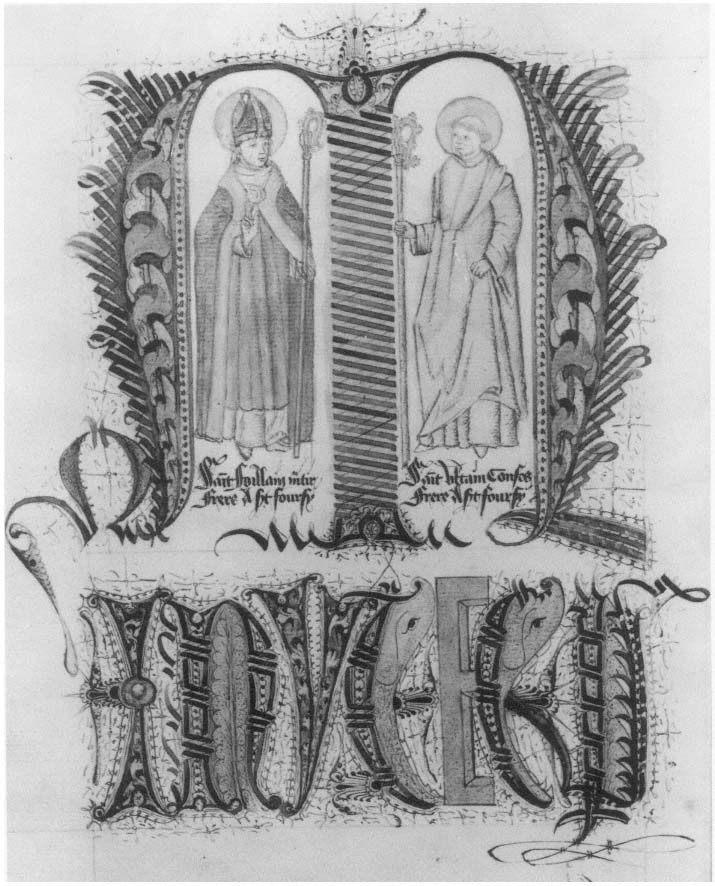
III-15
Historiated initial for "MINUTE."
Jean Miélot workbook.
Bibliothèque Nationale, Paris, Ms. fr. 17001, fol. 4 recto.
The sketch for an illustration on 5 verso (fig. III-16) shows an interior scene captioned "(C)oment Maistre Jehan mielot prestre Indigne chano(i)ne de lille: presente sa translation." The giant P at the left leads into the text which explains the functions of a prologue, a prohemium, and a preface, possibly a trial page for a de luxe manuscript.
The translation of the letter of Cicero to his brother Quintus follows on folios 8 to 25 and ends with "dans l'an mil CCCC, soixante huyt" (1468). A copy of this translation is preserved also in the Royal Library at Copenhagen.[21] On folio 26 recto is inscribed "Fait a Lille," on 26 verso "Par Moy" in illuminated capitals and letters, and on 27 recto appears another maze in a different form but again with the letters of Miélot's name inserted.
The workbook also contains a draft for the translation of the Briève compilation des histoires de toute la Bible from the Latin text of Jean d'Udine, which appears, as another minute on paper, in the Brussels Library, Ms. II 239 (fig. III-17). In both cases the text and the drawings are inscribed side-turned. The preliminary sketch for a schematic map follows, showing the division of the earth after the Deluge into the three continental sections for the sons of Noah. A more finished form is found in the same Brussels Ms. II 239, which also contains a Miélot drawing of a presentation, showing the Duke receiving the book in his bedchamber with clerics and courtiers in attendance and, on 54 verso, a genealogy of the Miélot family.
The last text in Ms. fr. 17001 is the Histoire du mors de la pomme , a sequence of dialogues in verse, possibly one of Miélot's rare attempts at authorship, with each page illustrated with crude line drawings. His listed works are almost entirely devoted to translations, edited versions, and transcriptions of the works of others.[22]
Two miniatures of a much later date appear on the last two pages of the volume. The first shows St. Luke at an easel, with his symbol, the ox, lying beside it and an angel behind him mixing ink or paint on a stone. At the left the Virgin Mary is posing for her portrait with book in hand. The pictures of the Virgin that St. Luke was said to have painted in the first century are all works of a much later date.[23] The second image is of St. Matthew writing in an open, bound book, while a kneeling angel, his symbol, holds out the pot of ink. Miélot may have copied these from admired models (fig. III-18).
A very revealing study could be made of the relationship of this manuscript to Brussels Ms. II 239 and the Copenhagen copy of the Cicero letter. In any case, Ms. fr. 17001 is of great interest in the study of the preparation and production of codices. It is a remarkable example of the workbook of a scribe, illuminator, and translator of the prolific Burgundian court.
[21] N. C. L. Abrahams, Description des manuscrits français du moyen âge de la Bibliothèque Royale de Copenhague (Copenhagen, 1844), p. 33.
[22] Lutz and Perdrizet, op.cit. , pp. 108–111; F. A. F. T. Reiffenberg, Bulletin du Bibliophile Belge , II (Brussels, 1867), p. 381.
[23] Donald Attwater, The Penguin Dictionary of Saints (Harmondsworth, 1965), p. 223.
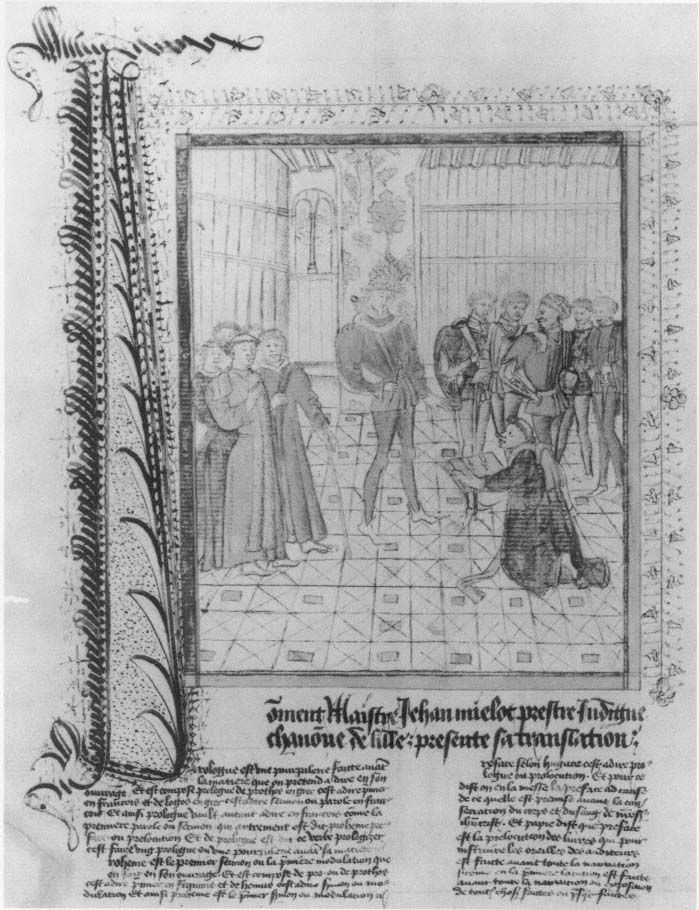
III-16.
Jean Miélot presents his translation to Philip the Good. Trial page.
Jean Miélot workbook.
Bibliothèque Nationale, Paris, Ms. fr. 17001, fol. 5 verso.

III-17.
Briève compilation des histoires de toute la Bible .
Bibliothèque Royale, Brussels, Ms. II 239, fol. 1 recto.
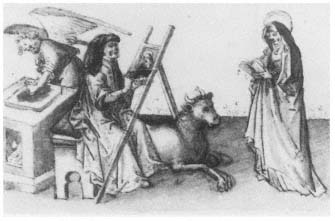
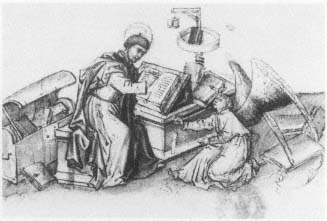
III-18.
The last two sketches in Miélot's workbook.
a. St. Luke painting a portrait of the Virgin Mary.
b. St. Matthew writing the Gospel.
Bibliothèque Nationale, Paris, Ms. fr. 17001, fols. 115 verso and 116 recto.